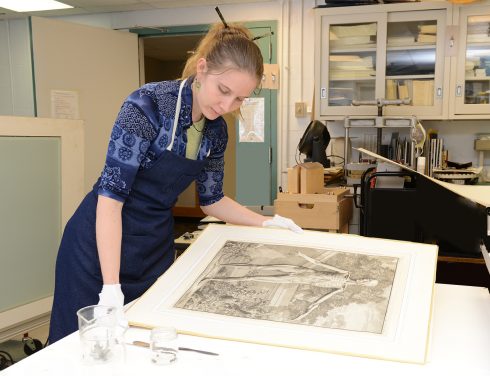Kristi Wright ’04
Kristi Wright is a self-employed conservator living in Front Royal, Virginia. We’re sure you’ll enjoy reading about her unique career. This is part 2 in our weekly summer blog series in which we highlight some of the amazing Furman alumni who have gone on to work in library and information professions. Click here to view all posts in this series. Wright graduated from Furman University in 2004 with a bachelor of arts degree in history and music. Then in 2005 she completed her master’s in library and information science from the University of South Carolina. As you’ll read below, it was some of the experiences she had at USC and her background in history and music that led her to her current role as a conservator!
Tell us a little bit about how you chose to work as a library and information professional?
I’ll confess that I initially chose to enter the world of library and information science because I wasn’t sure exactly what I wanted to do after graduating from Furman. I had degrees in both history and music but no clear path or passion for a career. Learning and research remained passions of mine, though, and holing up in a secluded corner on the top floor of the Furman Library was one of my favorite places to be. I also accrued many hours as a library volunteer while in high school. Why not pursue a career in libraries? You may be thinking that this does *not* constitute a clear career goal and you’d absolutely be correct – there are many opportunities to pursue in a library program! Once in graduate school I honed in on two paths, either music librarianship or preservation, as a preferred focus for my studies. I enjoyed these study directions and was honing in on preservation when the book repair opportunity described above appeared. It was really that opportunity and Holly’s subsequent (and continued!) mentorship that opened the world of conservation to me and set my career in motion.
What has been your professional path to your current position?
While I was in graduate school at the University of South Carolina I saw an email requesting volunteers to learn book repair at the USC library annex. I immediately signed up and started learning the hand-skills necessary to repair well-loved and heavily-used library books to functionality a circulating collections. I have a background in history and a strong interest in preserving historic materials and the conservator who taught the course, Holly Herro, soon also began training me in special collections materials. While there are several specific graduate programs available now, book and paper conservation is a trade that traditionally trained people via an apprenticeship structure and many people still enter the field using this path. I also pursued additional courses in chemistry in order to gain an understanding of the ways materials deteriorate and effective methods to slow these processes. After several years working full time in the USC lab, I moved to the Washington, DC area and began work as a contract conservator. Now, about fifteen years into my career, I work on both institutional collections at the federal, state, and county levels as well as on individuals’ books and documents.
What is the most interesting library in which you’ve worked?
I currently do a lot of contract work in the History of Medicine Division of the National Library of Medicine in Bethesda, Maryland. The NLM, part of the National Institutes of Health, is the largest medical library in the world. The collections are quite intriguing, and working with them is an eye-opening foray into the breadth of medical history – we have come such a long way and there is always ample work going on! At the NLM I’ve had the opportunity to work on an exciting variety of collections ranging from incunabula to Nobel laureates’ manuscripts. As part of my regular work there I conserve collection items, mount items for physical exhibitions, and participate in select research projects. Currently we are in the middle of a multi-institutional collaborative project investigating the potential impact of changes in leather production and use on the longevity of leather bookbindings. Some of this research is highlighted on the library’s blog.
What is something you have been surprised by during your career?
One exciting aspect of conservation is the juxtaposition of the old and the new. We are continually focused on preserving historic items and much of this requires an understanding of historic techniques and processes. However, modern analysis allows us to pursue the best materials and methods to use on these items. Conservation is a field where art and science cross paths frequently. Thus, not only do I use equipment and methods that have been around for centuries, I also get to stay up-to-date on emerging analytical techniques.
Is there a particularly fond memory from your time at Furman that you would be willing to share?
I think the area has been altered by subsequent renovations. but one of my favorite places to study was the top (third?) floor of the Furman Library. I used to go past the special collections cage and find a secluded table near a window. I loved hiding away from the bustle of campus life, being ensconced in the stacks, and, of course, surrounded by the smell of the old books (which I now know is actually the wood-pulp paper breaking down, but that doesn’t diminish my memory in the slightest). Back then, I didn’t know how much of my future would be tied to libraries and I was usually escaping to my quiet alcove a bit stressed out by an upcoming term paper or exam. Now, though, it’s a fond memory and one I often think back to when surrounded by library stacks in my professional life.


Comments
One response to “Furman Alumni Librarians Part 2: Kristi Wright ’04”
So proud of Kristi. Great to be a part of her life and family.